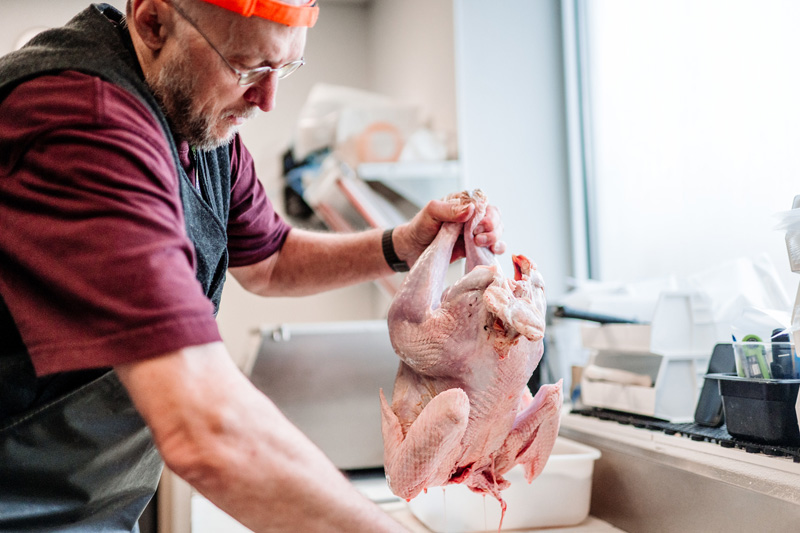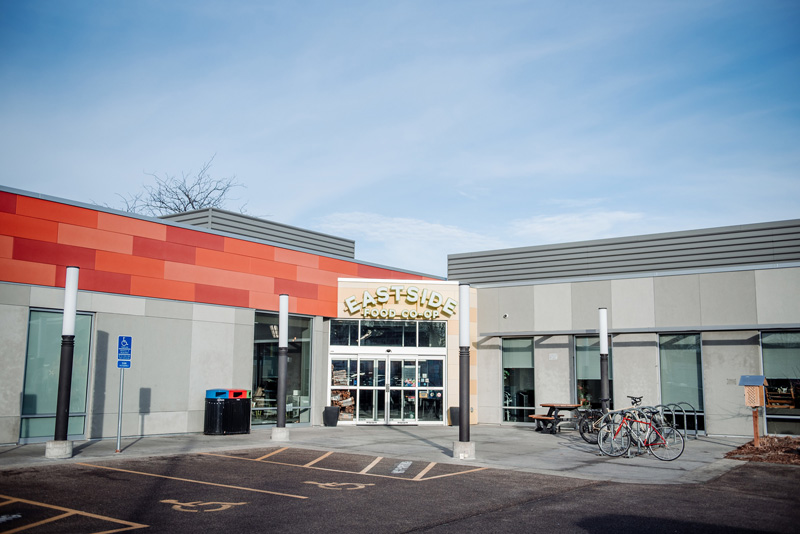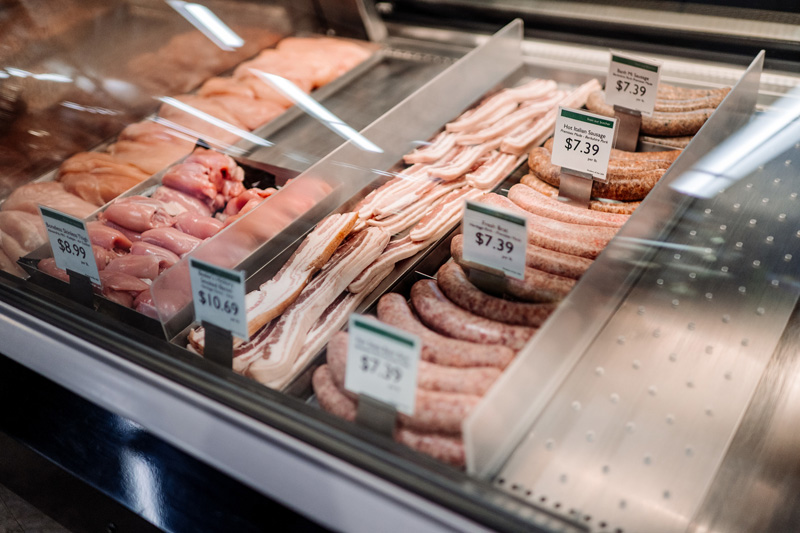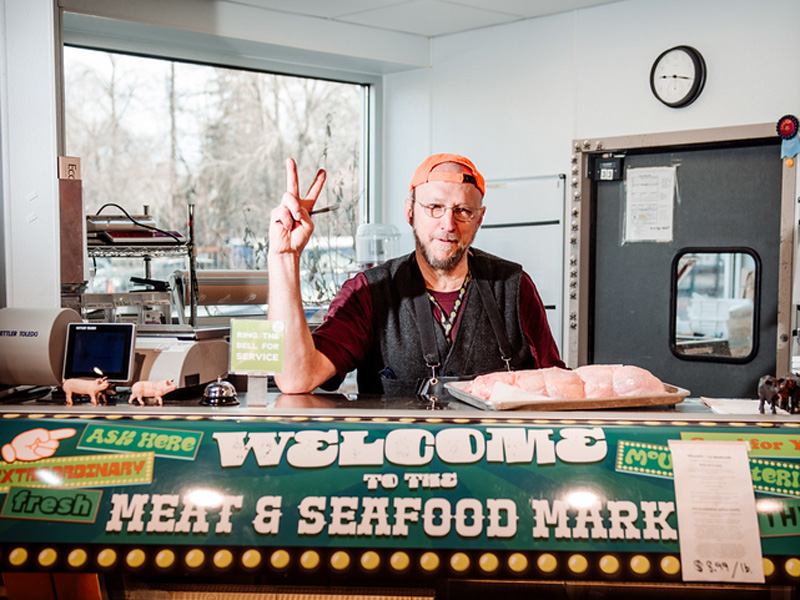Photographs by Becca Dilley / Heavy Table
This story originally appeared in the Feb. 16, 2024 edition of the Tap newsletter supported by Heavy Table’s Patreon backers. Subscribe on Patreon to keep the Heavy Table and get the newsletters.
Getting Karl Gerstenberger to talk about meat is easy, especially if you agree to meet him somewhere on 38th Street in Minneapolis. “For inspiration, there’s Finer Meats, Everett’s, the Seward Friendship Store, and Clancey’s. I like to see what’s going on with those folks.” On arrival, Gerstenberger fills the doorway at Clancey’s Meat & Seafood with his extra-tall Carhartt overall-clad frame. I offer to grab him a kombucha and we settle in for a chat, while Clancey’s Kristin Tombers serves late lunchtime customers.

RANCHES, RESTAURANTS, RETAIL CO-OPS
Gerstenberger has spent the past few decades immersing himself in the world of craft meats and nose-to-tail butchering, with a particular bent towards locally-raised, ethically farmed meats and poultry. “I worked on a dude ranch and a working cattle ranch for two summers when I was in college and really got interested in the livestock side of it. How are the animals raised? Who’s involved? What does it look like, sound like, what’s the work like?” After college, as an apprentice cook and sous chef at Bay Area restaurants Chez Panisse and Oliveto, he learned how to break down ducks, hogs, and lamb, and the thinking behind nose-to-tail cooking. Under the tutelage of chef Paul Bertolli, he was introduced to traditional Italian salumeri. For the past decade, Gerstenberger has been using his knowledge of meat and culinary expertise in co-op grocery stores, currently at Eastside Food Co-op.
His trajectory from restaurant to retail was accelerated by the birth of his daughter, twenty years ago. “In short weeks, I was working fifty hours as a sous chef, and often longer than that. From the standpoint of parenting and a quality family life, well, the writing was on the wall. So I did a five-year diversion as a private chef, which took me down to thirty hour weeks; and the pay doubled and tripled,” Gerstenberger remembers. “Unfortunately it was a little bit dry in terms of what I value restaurants for: the social interaction, and the high wire act. Restarting my restaurant life in Minnesota was a challenge; I wasn’t really able to get traction in a way that I could see myself enjoying that career, other than restaurant ownership. The investment and commitment that requires is pretty onerous.”

After a stint managing the kitchen at St. Paul’s Waldmann Brewery, Gerstenberger took meat processing courses at Iowa State and the University of Minnesota, and got a job at Lorenz Meats, a family-run processing plant in Cannon Falls. “I learned production in a USDA-certified environment: sausage, cured meat. I did that for two years. I loved the work environment, but I didn’t love being in the car and commuting from Saint Paul.”
“There was an opportunity at Seward Co-op for a meat cutter. I always had deep affinity with co-ops due to my grandparents’ involvement starting in the 1940s, so I was aware of what a co-op was. There was a meat cutter at the Hanover Food Co-op who was super friendly to me throughout my childhood and became a favorite of mine. The co-op job was a chance for me to connect with that family history and learn the retail end of the meat business.”
Besides the family-friendly hours, Gerstenberger likes the opportunity co-ops afford to help people learn how to choose and cook ethically-raised meats while respecting the animals, the farmers, and the environment. “The butcher counter is my lectern. I don’t treat it exactly like that,” he chuckles, “because I can read my audience. I know if someone has had enough. But I have developed relationships with people and shared my culinary knowledge and passion for food from my time in the restaurant business.”
“Co-ops have morphed a little bit in recent years to be more like mainstream grocery stores,” he continues. “But they still have dedication to local farms; to storytelling about animals and the land, and the people that are involved in producing the food they sell.”
Asked what he was most proud of from his years at Seward, Lakewinds, and now Eastside, Gerstenberger points to a single metric: “Sales growth, particularly at Seward, where sales tripled during the time that I was there. The store expansion was a clear success, and our reputation grew due to the hard work it took to get there. Between the sausage program and the whole-animal cutting program, we were kicking butt at 15% of store sales in a high financial performance period.

“I really support the idea of what co-ops do. At Seward, we were identifying and helping local producers and the co-op movement through a program called P6 [now known as Community Foods]. Local product made up over 90% of our total meat sales (according to a 2022 study by National Co+op Grocers, an average 25% of co-op sales are attributable to local products, including dairy, baked goods, produce, and meat). That’s all about the strength of the local food system.”
Gerstenberger takes a swerve from co-op manager to co-op educator: “Co-ops, unlike regular grocery stores, leverage education, and the roots of that are in the Rochdale Movement. During the Industrial Revolution, factory owners were providing housing and food to their newly-urbanized, newly-concentrated workforces. They were controlling the game board, garnishing wages in return for supplying food, sometimes of questionable quality. But the Rochdale weavers [founders of an early consumer-owned co-op] said, ‘We’ve had enough.’ And that’s the impetus for the co-op movement: community control and transparency about food quality. I bring up that talking point at least once a week, because people are trying to figure out how what the Co-op is doing is different. It’s not greenwashing when we’re talking about educating people. It’s an actual obligation to be transparent about the food we sell.”
PRICES, PERSONNEL, PREDICTIONS
A question about where he sees meat, poultry, and seafood prices heading leads Gerstenberger back to transparency and trust at community-owned co-ops. “We have a pretty clear-cut price-setting discipline in place. We need to keep the lights on, grow wages, take care of building maintenance. Grocery margins are tight, and we’re trying to be as competitive as we can. But what’s unique about us is that we talk to our suppliers every week; we know them directly. Many of them have direct access to processing, to their feed supply, and distribution. It’s a system which to some extent, makes them a little bit insulated from what the rest of the world is doing.
“Here’s what happened last year with bird flu and turkey prices. There was huge flock loss. Minnesota is ‘Turkey Central’. There’s a story behind that story [Christopher Vondracek covered this well in the Star-Tribune in November 2023]. But a lot of the losses sustained by the turkey industry didn’t affect our poultry farmers at all. Our prices didn’t go wonky. We didn’t react to the market and try to gouge customers either. We want to maintain that relationship of trust by letting people know here’s our cost; here’s our goal, this is the price. That goes back to the original co-op movement: transparency around quality and pricing.”

Gerstenberger loops back to my request to predict price trends: “My gut feeling is that costs will continue to rise. Prices will continue to be a little volatile. That’s what makes the dollars you spend even more important: understanding the backstory; understanding what’s actually happening on the farm when you’re spending your your income on on animal protein. It can be like The Wizard of Oz, a colossal challenge to find out what goes on behind the curtain. How do you find something that’s authentic and not greenwashing or brand marketing? Look for some key knowledge-holders you can trust, and then spend your dollars there. What anchors it all is meat that’s high quality and delicious. If the ethics behind what you’re cooking are also strong, then you’re winning on multiple fronts simultaneously.”
I ask about the difficulty of finding staff since COVID, particularly skilled, trained workers who want to work in meat and seafood, and what the upward trend in sales of pre-packaged and ready-to-cook meat bodes for full-service departments like Eastside’s.
“We’re getting to the point where the only cutting device used to stock a meat department is a box cutter. Filling the shelves with compellingly plastic-wrapped brand-marketed meat: that’s what predominates. The stores that are that are still focusing on the skill and knowledge are becoming unicorns,” Gerstenberger responds. “The future of the industry is really at stake; not to be grim about it, but finding people who are motivated to learn, who see it as a full-fledged profession they can make a living at – that’s increasingly difficult. We’re still doing it all at Eastside. We have carcass cutting operation; we have locally supplied packaged meats; and then we have packaged goods coming from larger corporations. We’re bridging a couple of streams here, trying to satisfy lots of people.”
CECCHINI, CHICKEN LIVERS, COOKING
I ask Gerstenberger why people in the meat business seem so passionate about what they do. His answer is blunt, and has the smell of a hard truth.
“There’s death involved. It’s really stark. If you’re a hunter or fisherman, when there is life or death at stake, that’s a terrible time. For people who are really passionate about this stuff, it involves caring about life. That sounds really hard to wrap your head around. But it’s like this: don’t waste life. Dignify the people that raise the animal. Treat the animal with dignity, and dignify the environment.”
“There’s a guy that I cite a lot, a butcher in Tuscany who I learned about in the 1990s. The owner of Oliveto used to buy truffles directly from truffle hunters in Italy, and on one of his trips he interviewed Dario Cecchini. Cecchini wanted to be a veterinarian because he loved animals so much. But his family was in the meat business, and when key family members’ health was failing, he had to jump in and take over the business. He made peace with that, and somehow, it amplified his love of animals. He really wanted people to grasp and respect what he was doing. He’s doing what Kristen is here at Clancey’s a little bit; not just selling the meat, but also taking it a little further and selling food made from the meat. Cecchini’s restaurants are not like restaurants. He doesn’t care how a restaurant runs. Like I said, the butcher counter is a lectern, or a pulpit. For Cecchini, it’s the restaurant and the spit and the grill where he amplifies people’s understanding of what meat is and how to cook it with respect. The guy gets tearful when he talks about it.”

“Just within the past couple months, I met someone who has known Dario Cecchini for thirty years. A regular customer at Eastside came in and asked me if we had any fresh chicken livers. And I said, ‘Well, we’ve got frozen. Who wants fresh chicken liver and why?’ He said, ‘I have a cousin who’s coming from Italy. She wants to make chicken liver toast.’ Oh, wow! That got my attention because that’s my favorite thing to eat. Offal is really fire right now. To be able to take one of the cheapest ingredients in the store, and through a little bit of culinary knowledge, turn it into something that will wow you…it’s best to learn something like that with someone that knows how to do it. Then you can taste the dish as it’s supposed to taste. This woman also worked at Badia a Coltibuono in Tuscany, teaching for fifteen years. She was a pastry chef at a Michelin starred restaurant in Florence, where she lived for thirty years. We had dinner the other night, and we were talking the same language, to the dismay of the other three people who were there. It’s a huge world, but it’s extremely interwoven as well; it’s kind of mystical how the two of us got to meet.”
So how does Gerstenberger recommend shoppers get the best value for their dollar, buying (typically more expensive) meat from local, ethical producers? “When you walk into the store, with a little bit of guidance you can find something suitable for the cooking method you want to use. That requires you to have some understanding of the techniques of food preparation. The recipe-driven approach to cooking can be a little problematic; that’s where I fall on a different side of the fence.
“For instance, I have four cases of pork shoulder from Minnesota producers; no antibiotics, vegetarian-fed, clean, purebred. It’s very affordable. And I know the audience for my cooking: my wife and daughter. We have a repertoire of things we like, and we do a lot of braising in the winter. We try to cook to the size of the pot, buy a piece of meat that fits the vessel and the method we want to use, and then enjoy it for a week. That might sound a little monotonous, but we also have a chest freezer, which is one of the keys to cooking this way. You braise the pork shoulder, eat it for a couple of nights and freeze the rest. A while later you want to have taco night, so you grab some frozen pork and put it in the refrigerator at the beginning of the day. Once you get home, all you have to do is do prep some vegetables, heat the tortillas, and you’ve got a delicious meal.”
“It’s helpful to be coming from a restaurant background where the menu changed daily, which is what we did at Chez Panisse. But there’s a cornucopia of ingredients for you, so learning how to judge quality and what to do with your ingredients to not mess them up and allow them to taste like what they are, that’s worth your time. After that, it’s radically simple. There is a level of knowledge you have to have to start living with food that way, and I love to teach.”

